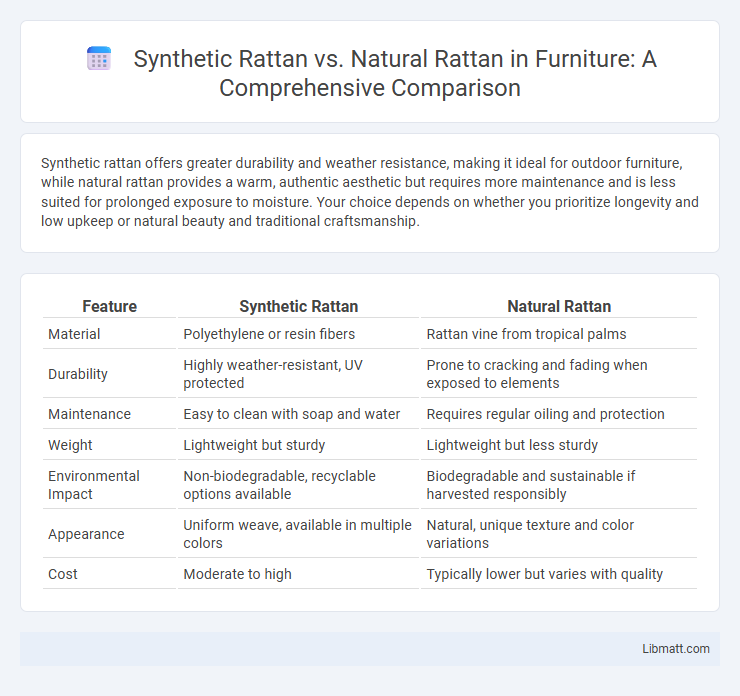Synthetic rattan offers greater durability and weather resistance, making it ideal for outdoor furniture, while natural rattan provides a warm, authentic aesthetic but requires more maintenance and is less suited for prolonged exposure to moisture. Your choice depends on whether you prioritize longevity and low upkeep or natural beauty and traditional craftsmanship.
Table of Comparison
| Feature | Synthetic Rattan | Natural Rattan |
|---|---|---|
| Material | Polyethylene or resin fibers | Rattan vine from tropical palms |
| Durability | Highly weather-resistant, UV protected | Prone to cracking and fading when exposed to elements |
| Maintenance | Easy to clean with soap and water | Requires regular oiling and protection |
| Weight | Lightweight but sturdy | Lightweight but less sturdy |
| Environmental Impact | Non-biodegradable, recyclable options available | Biodegradable and sustainable if harvested responsibly |
| Appearance | Uniform weave, available in multiple colors | Natural, unique texture and color variations |
| Cost | Moderate to high | Typically lower but varies with quality |
Introduction to Synthetic and Natural Rattan
Synthetic rattan is a durable, weather-resistant material made from polyethylene or resin, designed to mimic the appearance and texture of natural rattan, which is a flexible, lightweight vine harvested from tropical plants. Natural rattan offers an authentic, eco-friendly option with a unique, organic texture that complements traditional and rustic decor styles. Your choice between synthetic and natural rattan depends on factors like outdoor exposure, maintenance preferences, and desired aesthetic appeal.
Origin and Composition of Rattan Materials
Natural rattan originates from tropical climbing palms found primarily in Southeast Asia, composed mainly of organic cellulose fibers that provide flexibility and durability. Synthetic rattan, crafted from polyethylene or resin-based materials, mimics the appearance and texture of natural rattan while offering enhanced weather resistance and lower maintenance. Your choice between these materials depends on whether you prioritize the authentic feel and sustainability of natural rattan or the longevity and ease of care provided by synthetic alternatives.
Durability: Synthetic vs Natural Rattan
Synthetic rattan is highly durable, resistant to moisture, UV rays, and temperature fluctuations, making it ideal for outdoor furniture that withstands harsh weather conditions. Natural rattan, while offering a classic and authentic look, is prone to cracking, fading, and mold growth when exposed to prolonged moisture and sunlight. Your choice between synthetic and natural rattan should consider the intended use and environmental exposure to ensure long-lasting durability.
Weather Resistance and Outdoor Suitability
Synthetic rattan offers superior weather resistance compared to natural rattan, as it is made from durable polyethylene fibers that withstand UV rays, moisture, and temperature fluctuations without deteriorating. Natural rattan is prone to fading, cracking, and mold growth when exposed to prolonged sunlight and rain, making it less suitable for outdoor use without protective treatments. Outdoor furniture made from synthetic rattan requires minimal maintenance and remains attractive and functional in diverse weather conditions, outperforming natural rattan in longevity and resilience.
Maintenance Requirements Compared
Synthetic rattan requires minimal maintenance, needing only occasional cleaning with soap and water to remain durable and resistant to fading, moisture, and pests. Natural rattan demands more frequent upkeep, including regular dusting, avoidance of excessive moisture to prevent mold, and periodic application of protective oils or varnishes to maintain flexibility and prevent cracking. The low-maintenance nature of synthetic rattan makes it ideal for outdoor furniture in harsh weather conditions compared to the higher care needs of natural rattan.
Environmental Impact and Sustainability
Synthetic rattan, made from polyethylene or resin-based materials, offers higher durability and resistance to weather but involves fossil fuel consumption and non-biodegradable waste, contributing to environmental pollution. Natural rattan is a renewable resource harvested from tropical climbing palms, supporting ecosystem biodiversity and biodegradable properties, yet concerns exist over deforestation and the impact of unsustainable harvesting practices. Sustainable rattan sourcing and advances in recyclable synthetic rattan aim to balance environmental impact with durability and resource conservation.
Cost Differences and Affordability
Synthetic rattan is generally more affordable than natural rattan due to lower production and maintenance costs, making it a cost-effective choice for budget-conscious buyers. Natural rattan can be pricier because of its labor-intensive harvesting and treatment processes, along with its susceptibility to weather damage requiring regular upkeep. Your decision may hinge on balancing initial investment with long-term durability and maintenance expenses.
Aesthetic Appeal and Design Options
Synthetic rattan offers a wider range of colors and patterns, allowing for more versatile and modern design options compared to the earthy tones and natural variations of natural rattan. Its uniform texture and resistance to fading maintain aesthetic appeal over time, making it ideal for maintaining a sleek look in outdoor furniture. You can customize synthetic rattan to fit contemporary or traditional styles, while natural rattan preserves a classic, rustic charm with organic imperfections.
Common Uses in Furniture and Decor
Synthetic rattan is widely used in outdoor furniture and decor due to its resistance to weather, UV rays, and moisture, making it ideal for patios and garden settings. Natural rattan is favored for indoor furniture and decor pieces, offering a warm, organic aesthetic and lightweight durability, commonly found in chairs, baskets, and accent pieces. Both materials are popular in modern and traditional designs, with synthetic rattan providing longevity and low maintenance, while natural rattan emphasizes authenticity and natural texture.
Which Rattan is Right for You?
Synthetic rattan offers superior durability and resistance to weather, making it ideal for outdoor furniture that requires low maintenance and long-lasting performance. Natural rattan provides an authentic, eco-friendly aesthetic with a lightweight structure but demands more care to prevent damage from moisture and sunlight. Considering your lifestyle and usage, choose synthetic rattan for longevity and ease or natural rattan for a classic, natural look.
synthetic rattan vs natural rattan Infographic

 libmatt.com
libmatt.com